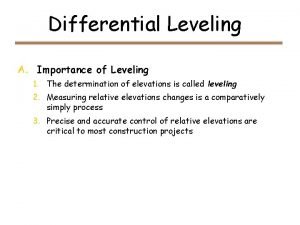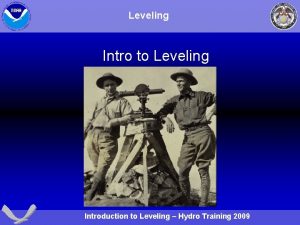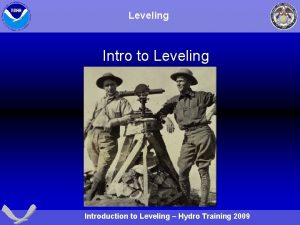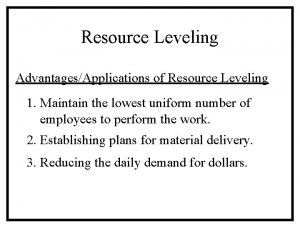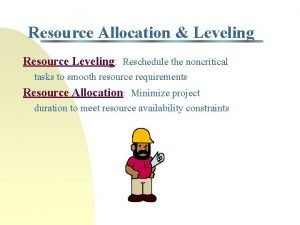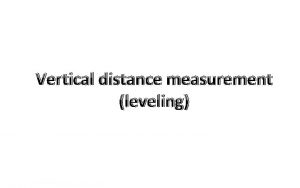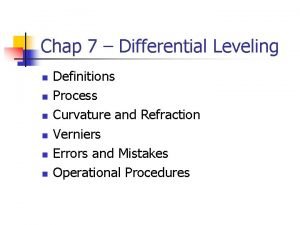Differential Leveling A Importance of Leveling 1 The





















- Slides: 21

Differential Leveling A. Importance of Leveling 1. The determination of elevations is called leveling 2. Measuring relative elevations changes is a comparatively simply process 3. Precise and accurate control of relative elevations are critical to most construction projects

The Level A level consist of a high-powered telescope The level is attached to a spirit or bubble level that keeps the line of sight of the telescope horizontal


Level Instrument

Leveling staff Types: 1. Self reading A. Solid staff B. Folding staff 2. Target staff

Level Instrument-Wye level

Differential Leveling Definitions 1. Bench mark (BM) - relatively permanent point of known elevation BS = 6. 32 ft HI = 106. 32 ft Point A FS = 3. 10 ft Point B Elevation = 103. 22 m Starting point (elevation 100. 00 m)

Differential Leveling Definitions 2. Backsight (BS) - a sight taken to the level rod held at a point of known elevation (either a BM or TP) BS = 6. 32 ft HI = 106. 32 ft Point A FS = 3. 10 ft Point B Elevation = 103. 22 m Starting point (elevation 100. 00 m)

Differential Leveling Definitions 3. Height of instrument (HI) - the elevation of the line of sight of the telescope BS = 6. 32 m HI = 106. 32 m Point A FS = 3. 10 m Point B Elevation = 103. 22 m Starting point (elevation 100. 00 m)

Differential Leveling Definitions 4. Foresight (FS) - a sight taken on any point to determine its elevation BS = 6. 32 ft HI = 106. 32 ft Point A FS = 3. 10 ft Point B Elevation = 103. 22 ft Starting point (elevation 100. 00 ft)

Differential Leveling D. Computation of Elevations BS 12. 64 BM 1 1. BS + Elevation = HI Elevation 100. 00 Point BM 1 BS 12. 64 HI 112. 64 FS Elevation 100. 00

Differential Leveling Computation of Elevations BS 12. 64 FS 3. 11 BM 1 Elevation 100. 00 Point BM 1 TP 1 2. HI - FS = Elevation TP 1 BS 12. 64 HI 112. 64 FS 3. 11 Elevation 100. 00 109. 53

Differential Leveling Computation of Elevations BS 12. 64 FS 3. 11 BS 10. 88 BM 1 TP 1 Elevation 100. 00 Point BM 1 TP 1 BS 12. 64 10. 88 HI 112. 64 120. 41 FS 3. 11 Elevation 100. 00 109. 53

Differential Leveling Computation of Elevations BS 12. 64 FS 3. 11 BS 10. 88 FS 2. 56 TP 2 BM 1 TP 1 Elevation 100. 00 Point BM 1 TP 2 BS 12. 64 10. 88 HI 112. 64 120. 41 FS 3. 11 2. 56 Elevation 100. 00 109. 53 117. 85

Differential Leveling Computation of Elevations BS 12. 64 FS 3. 11 BS 10. 88 FS 2. 56 TP 2 BM 1 TP 1 Elevation 100. 00 Point BM 1 TP 2 BS 9. 72 BS 12. 64 10. 88 9. 72 HI 112. 64 120. 41 127. 57 FS 3. 11 2. 56 Elevation 100. 00 109. 53 117. 85

Differential Leveling Computation of Elevations BS 12. 64 FS 3. 11 BS 10. 88 FS 2. 56 FS 3. 10 BM 2 TP 2 BM 1 TP 1 Elevation 100. 00 Point BM 1 TP 2 BM 2 BS 9. 72 BS 12. 64 10. 88 9. 72 HI 112. 64 120. 41 127. 57 FS 3. 11 2. 56 3. 10 Elevation 100. 00 109. 53 117. 85 124. 47

Differential Leveling Computation of Elevations BS 12. 64 FS 3. 11 BS 10. 88 FS 2. 56 FS 3. 10 BM 2 TP 2 BM 1 TP 1 Elevation 100. 00 Point BM 1 TP 2 BM 2 BS 9. 72 BS 12. 64 10. 88 9. 72 HI 112. 64 120. 41 127. 57 FS 3. 11 2. 56 3. 10 Elevation 100. 00 109. 53 117. 85 124. 47

Differential Leveling Computation of Elevations 3. Change in elevation- summation of the backsight and the foresight then subtract Point BM 1 TP 2 BM 2 BS 12. 64 10. 88 9. 72 +33. 24 HI 112. 64 120. 41 127. 57 FS 3. 11 2. 56 Elevation 100. 00 109. 53 117. 85 3. 10 124. 47 -8. 77 Change in elevation = 33. 24 -8. 77 =24. 47

Differential Leveling 4. The initial backsight (BS) is taken to a point of known elevation 5. The backsight reading is added to the elevation of the known point to compute the height of the instrument (HI) 6. The level may be moved to a temporary point called a turning point (TP) 7. The elevation of a point is the height of the instrument (HI) minus the foresight (FS)

Differential Leveling Computation of Elevations - Group Problem z Prepare a set of level notes for the survey illustrated below. What are the elevations of points TP 1 and TP 2? BS 1. 27 BM FS 4. 91 BS 2. 33 FS 6. 17 Elevation 356. 68 TP 1 TP 2

Differential Leveling Computation of Elevations - Group Problem BS 1. 27 FS 4. 91 BS 2. 33 BM FS 6. 17 Elevation 356. 68 TP 1 Point BM 1 TP 2 BS 1. 27 2. 33 +3. 60 HI 357. 95 355. 37 FS 4. 91 6. 17 -11. 08 Elevation 356. 68 353. 04 349. 20 -7. 48 TP 2
 Differential levelling definition
Differential levelling definition Differential leveling example
Differential leveling example Leveling
Leveling Bm
Bm Profile leveling definition
Profile leveling definition Thiếu nhi thế giới liên hoan
Thiếu nhi thế giới liên hoan Hát lên người ơi
Hát lên người ơi điện thế nghỉ
điện thế nghỉ Một số thể thơ truyền thống
Một số thể thơ truyền thống Trời xanh đây là của chúng ta thể thơ
Trời xanh đây là của chúng ta thể thơ Sơ đồ cơ thể người
Sơ đồ cơ thể người Bảng số nguyên tố lớn hơn 1000
Bảng số nguyên tố lớn hơn 1000 Tỉ lệ cơ thể trẻ em
Tỉ lệ cơ thể trẻ em Tia chieu sa te
Tia chieu sa te đặc điểm cơ thể của người tối cổ
đặc điểm cơ thể của người tối cổ Các châu lục và đại dương trên thế giới
Các châu lục và đại dương trên thế giới ưu thế lai là gì
ưu thế lai là gì Các môn thể thao bắt đầu bằng từ đua
Các môn thể thao bắt đầu bằng từ đua Tư thế ngồi viết
Tư thế ngồi viết Cái miệng nó xinh thế
Cái miệng nó xinh thế Hình ảnh bộ gõ cơ thể búng tay
Hình ảnh bộ gõ cơ thể búng tay Mật thư tọa độ 5x5
Mật thư tọa độ 5x5
